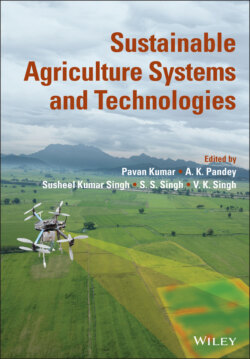Читать книгу Sustainable Agriculture Systems and Technologies - Группа авторов - Страница 57
4.5 The Economic Challenges of Local Farmers
ОглавлениеIndia is an agricultural sector country and about 263 million people are directly engaged in farming in which only 45% have their own cropland. Rest 55% peoples rely on other nonagricultural occupation for their livelihood (Lowe and Roth 2020; Mahendra Dev and Sengupta 2020). Before COVID‐19, the part of the GDP of India stemming from the agricultural sector experienced growth rates at around 3.2% per year for six continuous years from 2014 to 2019 and expected a similar growth of between 2.4 and 3.7% from the fiscal year 2019 (FY19) to the fiscal year 2020 (FY20) (National Statistical Office of India). This expected growth has been replaced by a sharp decline of about 5% in the first quarter (Q1) of the 2020 fiscal year (FY) due to the lockdown (FAO 2020). Trends in the agricultural part of the GDP of India can largely be attributed to variations in wages in the agricultural sector and hence to the operation of local farming systems. Figure 4.4 compares recent variations of the average wage related to agricultural activities (“agri wages,” blue curves) vs. the average wage related to nonagricultural activities (“nonagri wages,” brown curves) in India's rural areas (i.e. “rural wages”). The average wages are here differentiated into nominal and real wage, respectively. In general, progression in the real wage is linked to changes in the overall national GDP of India, whereas progression in nominal wages relate to the market conditions for agricultural products.
Figure 4.3 Timeline of Finance Minister announces lockdown restrictions in India.
Source: https://prsindia.org.
Figure 4.4 (Top panel) Variations in the average nominal wage (agriculturally related vs. nonagriculturally related in rural areas). (Bottom panel) Variations in the average real wage in rural areas based on data from RBI, accessed 16 May 2020. (See insert for color representation of the figure.)
From 2015 to 2020, the average nominal wage has decreased from 4.3 to 0.86% (Figure 4.2). Meanwhile, the real wage exhibited large fluctuations but as of December 2019 is negative for both the agricultural wage and nonagricultural wage. As expected this is synchronized with the drop in the national GDP of India seen from 2018 to 2019 (Figure 4.1). Meanwhile, the former seems to suggest that the current agricultural production in India is substantially higher than the demand. Combined, the data depict a situation, where despite an overall longtime positive growth of the Indian agriculture.
